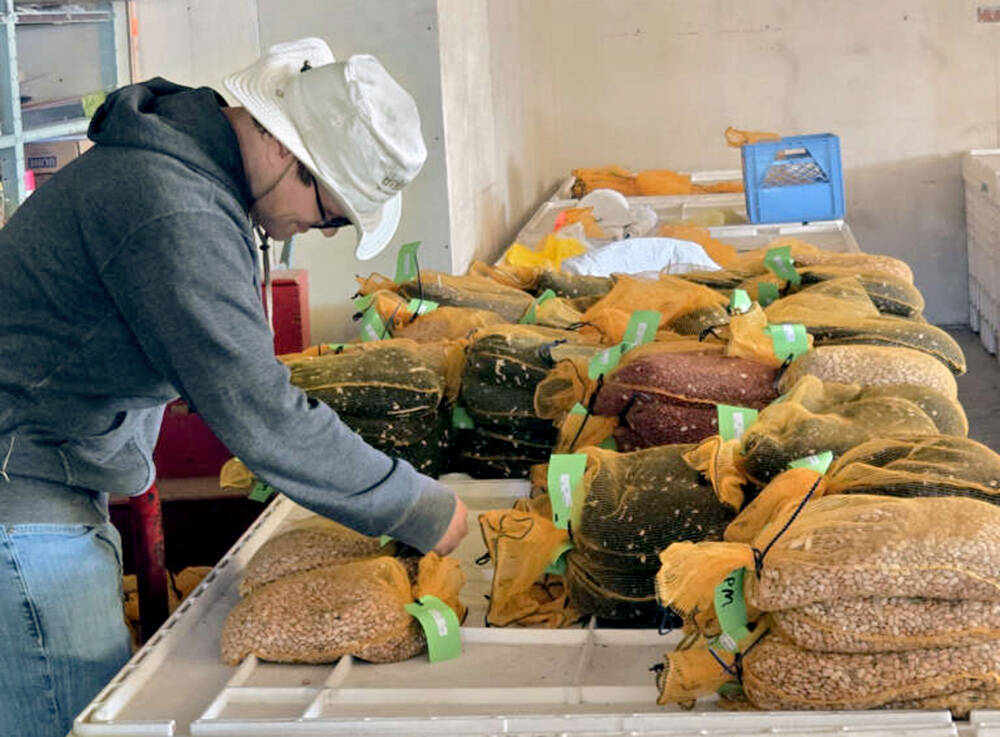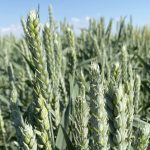This month, traders will be focused on the U.S. planting pace and North American weather. Last month, a large portion of Ontario received over 150 per cent of normal precipitation.
Quick look
Soybeans: Argentina will dominate the soymeal and soyoil market over the next month as harvest nears 20 per cent complete. Brazil’s soybean export offers have increased but remain at a sharp discount to U.S.
Corn: U.S. export offers continue to dominate the world market, tightening old crop fundamentals. This comes on the heels of lower U.S. planted acreage.
Wheat: Eastern Ukraine and southern Russia are experiencing drier conditions, causing traders to lower production forecasts amid the ongoing conflict.
Soybeans
Read Also

Bean research breeds community giving
University of Guelph dry bean researcher Dr. Mohsen Yoosefzadeh Najafabadi champions sustainability by donating surplus breeding program beans to support food security and community art initiatives.
The Ontario soybean market is characterized by limited farmer selling and sluggish demand. Canadian processors are expected to crush 155,000 tonnes of soybeans during April and 145,000 tonnes during May. However, the June crush is expected to dip to only 100,000 tonnes. Domestic demand will increase in July as the crush increases to 150,000 tonnes.
Argentina dominates the world market for soymeal and soyoil in the spring, causing U.S. exports to slow and resulting in softer North American prices. Ontario soybean exports will move through a seasonal low from May through July due to strong competition from Brazil.
Ontario soybean exports from April 1 through July 31 are estimated at 500,000 tonnes. Farmer selling tends to slow in May and then increases during June and July. The domestic crusher will probably import 100,000 tonnes from May 1 through July 31, which will take the steam of any potential basis strength.
As of April 26, U.S. soybeans were offered at US$450/tonne f.o.b. the Gulf while Brazilian soybeans were valued at $435/tonne f.o.b. Paranagua. Ontario soybeans were offered at US$455/tonne f.o.b. St. Lawrence port.
The world soybean market is digesting South American harvest pressure and North American production forecasts. The Argentinean harvest was nearing 20 per cent complete as of April 28 and world soymeal and soyoil are under pressure.
Argentine output is now estimated at 50 -51 million tonnes, up from 25 million tonnes last year. The Brazilian harvest is 95 per cent complete. Estimates range from 145-155 million tonnes, down from the previous harvest of 162 million tonnes. Basis levels are slowly increasing in Brazil but softening in Argentina.
Conditions are favourable in the U.S. for planting soybeans. U.S. forecasts continue to hover around 116 million tonnes, up about 2.9 million tonnes from last year. Between now and harvest, the price of U.S. soybeans will transition from premium to discount to Brazilian origin.
U.S. meal and oil exports will slow due to the larger Argentine crop and there is a big U.S. crop coming. The U.S. farmer will be an aggressive seller during the fall. China could implement tariffs on U.S. soybeans over the winter.
Palm oil fundamentals are tightening in Malaysia and Indonesia, which is positive for the oil component. This is something to watch longer term. Middle East tensions will continue to underpin the biodiesel demand for the soyoil.
What to do: We continue to forecast an Ontario soybean crop of four million tonnes, unchanged from last year. We’ve advised farmers to be 80 per cent sold on their 2023 production and 20 per cent sold on new crop. We’ll wait until the upcoming crop is more certain before selling the final 20 per cent.
Corn
The Ontario corn market is characterized by seasonal low farmer selling and increasing demand. Total number of cattle on Ontario feeding operations on July 1 is expected to be 315,000 head. This is up 20,000 head from Jan. 1. Total hogs in Ontario on July 1, are estimated at 3.6 million, unchanged from Jan. 1 and unchanged from July 1, 2023.
While domestic feed demand is constant, exports are expected to increase during May through July. Stronger offshore demand should result in higher Ontario corn prices. Ontario on-farm stocks at the end of September are expected to drop to historical lows. This should result in stronger basis levels.
As of April 26, U.S. corn was offered at US$195/tonne f.o.b. the Gulf, up $5/tonne from 14 days earlier. Brazilian corn was quoted at $208/tonne f.o.b. Paranagua, up $3/tonne from our previous issue. Argentine corn was quoted at $215/tonne f.o.b. tidewater. French corn was quoted at $218/tonne f.o.b. La Pallice. Ontario corn remains competitive into Northern European ports with quoted values at $194/tonne f.o.b. St. Lawrence port.
The Argentine corn crop was approximately 20 per cent harvested as of April 26. In our previous issue, we mentioned that Argentina’s corn production estimates were decreasing due to leafhoppers and corn stunt disease. Trade estimates suggest that 25 to 30 per cent of the crop is infected but some analysts’ estimates are as high as 40 per cent. Crop estimates range from 51-55 million tonnes, up from last year’s output of 36 million tonnes.
In Brazil, the first corn crop harvest has been completed and production estimates are around 25 million tonnes. The second crop known as the Safrinha production is uncertain. Acreage is down from last year by nearly 10 per cent and drier conditions have materialized during the pollination stage. Total corn production figures range from 108 to 124 million tonnes, down from 137 million tonnes last year.
The U.S. needs to carry the world in corn until late June and July. U.S. export sales are running 17 per cent ahead of last year and we’re expecting the USDA to increase its export projection for the 2023-24 crop year. U.S. production for 2024 is expected to finish near 363 million tonnes, down from 390 million tonnes last year. The corn fundamentals cannot afford a crop problem in the U.S. this summer.
What to do: We’ve advised farmers to be 70 per cent sold on their 2023 production. We’re waiting for the North American corn market to incorporate a risk premium due to the uncertainty in U.S. production and lower Brazilian output. We’re planning to finish up sales in June or July.
Last year, the corn futures rallied a $1/bu. in mid-June on drier weather so we could see a similar pattern this year. In many years, the wheat market leads the corn market so the recent rally in wheat may be a sign of things to come.
Wheat
As of April 26, Ontario soft red winter wheat prices had rallied nearly 70 cents/bu. off the March low, while hard red values have risen $1/bu. over the previous 30 days. In addition to the stronger futures market, basis levels have strengthened due to lack of farmer selling.
Ontario farmers produced 2.666 million tonnes of wheat in 2023 and sold nearly 80 per cent of their production in the first five months of the crop year. On farm stocks as of Dec. 31 were 571,000 tonnes.
On May 7, Statistics Canada will release the March 31 supplies. We’re expecting on-farm wheat stocks to come in at 250,000 tonnes, which is about nine per cent of the production.
This is a prime example why you don’t sell all your wheat in the fall period. Prices have rallied and many farmers have nothing to sell. Farmers following our advice have 20 per cent of the crop left in storage on-farm. For the 2023-24 crop year, Ontario wheat prices made their crop-year low around Sept. 30, 2023.
The bulk of the Russian winter wheat region received below normal precipitation in April. A significant portion received less than 50 per cent of normal. There are rains in the forecast for May 5 to 18. After May 20, there is another 30-day stretch where no major precipitation is forecasted.
If rains during the first half of May do not materialize, the Russian wheat crop will experience major yield drag due to drier conditions.
In Europe, winter wheat production will be down from last year but the main concern in Germany and France is quality and what portion of the wheat crop will be milling quality.
U.S. winter wheat conditions have also deteriorated. For the week ending April 1, the U.S. winter wheat crop was rated 50 per cent good to excellent, down five per cent from seven days earlier. There were rains in the forecast for the first week of May and this precipitation will be needed to sustain yield potential.
There are some drier pockets in Western Canada but most of the growing region received average precipitation in the last 30 days. World traders view Canada like Australia. The hard red spring wheat crop is always two weeks away from a drought and temperatures have been above average.
The longer term forecast for June and July calls for above normal temperatures and below normal precipitation. Some regions of Alberta and Saskatchewan will experience significant yield drag.
What to do: This week, we’re advising farmers to sell 10 per cent of their 2023 production, bringing total sales to 90 per cent. We’ll save the final 10 per cent in case rains don’t develop in the U.S. or Russia as expected.













